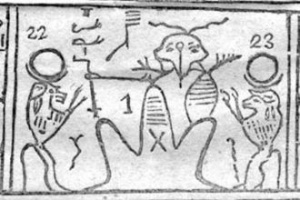Kolob: Difference between revisions
| Line 32: | Line 32: | ||
==See Also== | ==See Also== | ||
[[ | [[Taphoth]] | ||
[[Category:Ascension]] | [[Category:Ascension]] | ||
Revision as of 18:57, 26 March 2015
Kolob is a star or planet described in Mormon scripture. Reference to Kolob is found in the Book of Abraham, a work that is traditionally held by adherents of the Mormon faith as having been translated from an Egyptian papyrus scroll by Joseph Smith, the founder of the Latter Day Saint movement. According to this work, Kolob is the heavenly body nearest to the throne of God. While the Book of Abraham refers to Kolob as a "star", it also refers to planets as "stars", and therefore, some Mormon commentators consider Kolob to be a planet.The idea also appears in Mormon culture, including a reference to Kolob in a Mormon hymn.[1]
Doctrine and exegesis

Description in the Book of Abraham:Facsimile No. 2 from the Book of Abraham, which Smith said discusses Kolob. The part Smith said refers to Kolob is numbered by a "1" in the center.
The first published reference to Kolob is found in the Book of Abraham, first published in 1842 in Times and Seasons and now included within the Pearl of Great Price as part of the canon of Mormonism. The Book of Abraham was dictated in 1836 by Smith after he purchased a set of Egyptian scrolls that accompanied a mummy exhibition. According to Smith, the scrolls described a vision of Abraham, in which Abraham:
"saw the stars, that they were very great, and that one of them was nearest unto the throne of God; ... and the name of the great one is Kolob, because it is near unto me, for I am the Lord thy God: I have set this one to govern all those which belong to the same order as that upon which thou standest."
In an explanation of an Egyptian hypocephalus that was part of the Joseph Smith Papyri, Smith interpreted one set of hieroglyphics as representing:
"Kolob, signifying the first creation, nearest to the celestial, or the residence of God. First in government, the last pertaining to the measurement of time. The measurement according to celestial time, which celestial time signifies one day to a cubit. One day in Kolob is equal to a thousand years according to the measurement of this earth, which is called by the Egyptians Jah-oh-eh." The Book of Abraham describes a hierarchy of heavenly bodies, including the Earth, the Moon, and the Sun, each with different movements and measurements of time, where at the pinnacle, the slowest-rotating body is Kolob, where one Kolob-day corresponds to 1000 earth-years. This is similar to Psalm 90:4 which says that "For a thousand years in [God's] sight are but as yesterday when it is past" and 2 Peter 3:8 which says, "one day is with the Lord as a thousand years". Additional, similar information about Kolob is found in the Kirtland Egyptian Papers, constituting manuscripts in the handwriting of Smith and his scribes.
Mormon exegesis and speculation
According to the traditional, literal Mormon interpretation of the Book of Abraham, Kolob is an actual star or planet in this universe that is, or is near, the physical throne of God. According to Smith, this star was discovered by Methuselah and Abraham[9] by looking through the Urim and Thummim, a set of seer stones bound into a pair of spectacles. LDS Church leader and historian B. H. Roberts (1857–1933) interpreted Smith's statements to mean that our solar system and its governing "planet" (the Sun) revolved around a star known as Kae-e-vanrash, which itself revolved with its own solar system around a star called Kli-flos-is-es or Hah-ko-kau-beam, which themselves revolve around Kolob, which he characterized as "the great centre of that part of the universe to which our planetary system belongs". Roberts was confident that this hierarchy of stars orbiting other stars would be confirmed by astronomers. The literal interpretation of Kolob as an actual star or planet had significant formative impact on Mormon belief and criticism, leading to conceptions such as that God dwells within this universe, and that the Biblical creation is a creation of the local earth, solar system, or galaxy, rather than the entire known physical reality.
In addition to the literal interpretation of Kolob as an actual heavenly body, the LDS Church has proposed that Kolob is also "a symbol of Jesus Christ", in that like Kolob, Jesus "governs" all the stars and planets similar to the earth. [2]
HGS Session References
HGS Sessions - Clearing Kolob Star - 3/26/2015 [3]

